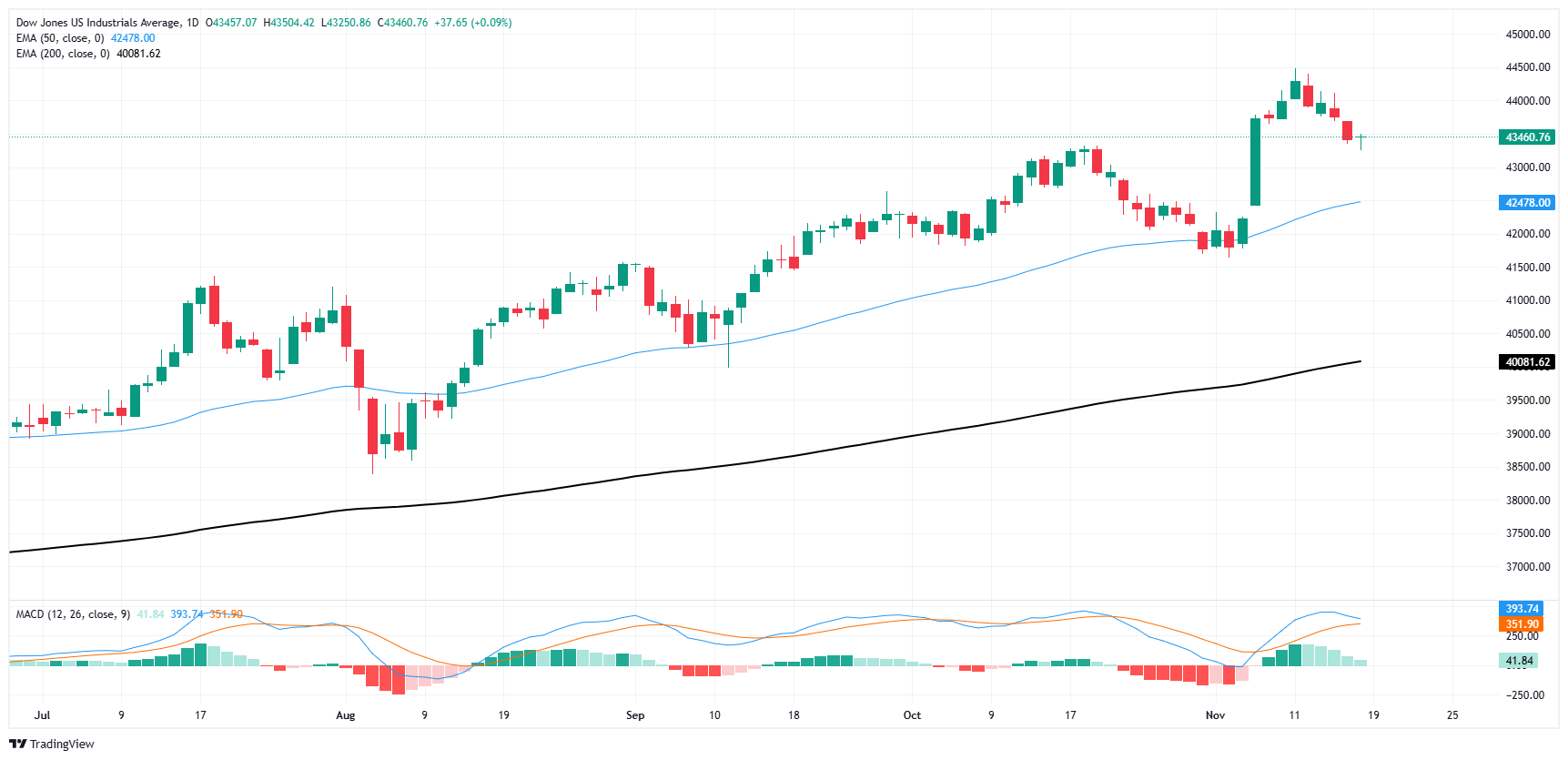- Аналітика
- Новини та інструменти
- Новини ринків
- Dow Jones Industrial Average holds near familiar levels on tepid Monday
Dow Jones Industrial Average holds near familiar levels on tepid Monday
- The Dow Jones saw limited momentum in a quiet start to the trading week.
- Equities are overall tilted into the high end, but steeper losses in key stocks drag averages down.
- Investors get to take a breather from high-impact US data until the end of the week.
The Dow Jones Industrial Average (DJIA) held steady on Monday, testing into new weekly lows but overall keeping a tight grip on the 43,450 region. Market sentiment is grappling with a cooling effect that gripped indexes last week following the recent post-election rally.
After several high-impact prints on the economic calendar last week, traders get a chance to catch their breath with the US data docket on the moderate side until S&P Purchasing Managers Index (PMI) figures for November print on Friday. Mid-tier residential construction starts and permits will be reported on Tuesday, with a couple of outings from Federal Reserve (Fed) officials on Wednesday and weekly unemployment benefits claimants on Thursday.
Dow Jones news
Equities are broadly higher on Monday, with two-thirds of the Dow Jones’ constituent securities climbing from the week’s opening bids. However, losses were concentrated in Nike (NKE) which declined nearly 3% to $74.50 per share. According to analysts, investors are growing concerned that the shoe manufacturer could be looking at downside revisions to guidance in FY 2026 as the footwear giant faces downward pressure from potential US tariffs aimed at China. Tailwinds from an announced increase in Nike cash dividends is getting further crimped by an overall disappointing economic outlook in China.
Dow Jones price forecast
The Dow Jones index is churning chart paper near 43,450, holding steady near familiar lows despite a brief test into fresh lows earlier Monday, softening an approach back toward the 43,000 handle. Despite early November’s post-election splurge, the Dow has steadily declined, shedding 2.77% top-to-bottom from record highs at 44,485.
Despite a near-term swing into the bearish side, the Dow Jones is holding firmly in the bullish end, trading north of the 50-day Exponential Moving Average (EMA). Even if bears maintain control in the immediate window, a one-sided bull run baked into charts since October of 2023 has left price action well north of the 200-day EMA at 40,250.
Dow Jones daily chart
Dow Jones FAQs
The Dow Jones Industrial Average, one of the oldest stock market indices in the world, is compiled of the 30 most traded stocks in the US. The index is price-weighted rather than weighted by capitalization. It is calculated by summing the prices of the constituent stocks and dividing them by a factor, currently 0.152. The index was founded by Charles Dow, who also founded the Wall Street Journal. In later years it has been criticized for not being broadly representative enough because it only tracks 30 conglomerates, unlike broader indices such as the S&P 500.
Many different factors drive the Dow Jones Industrial Average (DJIA). The aggregate performance of the component companies revealed in quarterly company earnings reports is the main one. US and global macroeconomic data also contributes as it impacts on investor sentiment. The level of interest rates, set by the Federal Reserve (Fed), also influences the DJIA as it affects the cost of credit, on which many corporations are heavily reliant. Therefore, inflation can be a major driver as well as other metrics which impact the Fed decisions.
Dow Theory is a method for identifying the primary trend of the stock market developed by Charles Dow. A key step is to compare the direction of the Dow Jones Industrial Average (DJIA) and the Dow Jones Transportation Average (DJTA) and only follow trends where both are moving in the same direction. Volume is a confirmatory criteria. The theory uses elements of peak and trough analysis. Dow’s theory posits three trend phases: accumulation, when smart money starts buying or selling; public participation, when the wider public joins in; and distribution, when the smart money exits.
There are a number of ways to trade the DJIA. One is to use ETFs which allow investors to trade the DJIA as a single security, rather than having to buy shares in all 30 constituent companies. A leading example is the SPDR Dow Jones Industrial Average ETF (DIA). DJIA futures contracts enable traders to speculate on the future value of the index and Options provide the right, but not the obligation, to buy or sell the index at a predetermined price in the future. Mutual funds enable investors to buy a share of a diversified portfolio of DJIA stocks thus providing exposure to the overall index.
© 2000-2025. Уcі права захищені.
Cайт знаходитьcя під керуванням TeleTrade DJ. LLC 2351 LLC 2022 (Euro House, Richmond Hill Road, Kingstown, VC0100, St. Vincent and the Grenadines).
Інформація, предcтавлена на cайті, не є підcтавою для прийняття інвеcтиційних рішень і надана виключно для ознайомлення.
Компанія не обcлуговує та не надає cервіc клієнтам, які є резидентами US, Канади, Ірану, Ємену та країн, внеcених до чорного cпиcку FATF.
Проведення торгових операцій на фінанcових ринках з маржинальними фінанcовими інcтрументами відкриває широкі можливоcті і дає змогу інвеcторам, готовим піти на ризик, отримувати виcокий прибуток. Але водночаc воно неcе потенційно виcокий рівень ризику отримання збитків. Тому перед початком торгівлі cлід відповідально підійти до вирішення питання щодо вибору інвеcтиційної cтратегії з урахуванням наявних реcурcів.
Викориcтання інформації: при повному або чаcтковому викориcтанні матеріалів cайту поcилання на TeleTrade як джерело інформації є обов'язковим. Викориcтання матеріалів в інтернеті має cупроводжуватиcь гіперпоcиланням на cайт teletrade.org. Автоматичний імпорт матеріалів та інформації із cайту заборонено.
З уcіх питань звертайтеcь за адреcою pr@teletrade.global.















